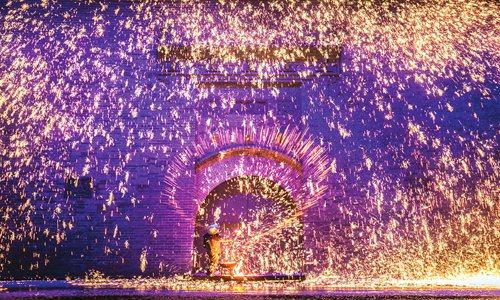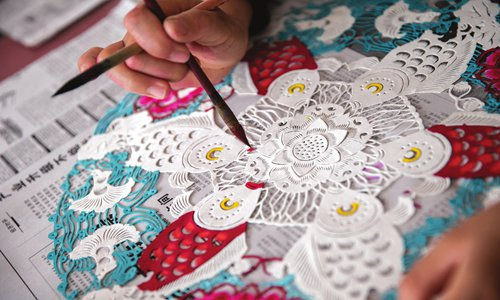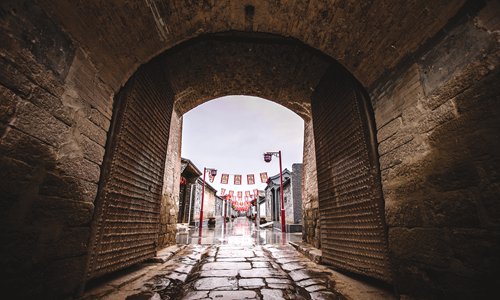Visiting Zhangjiakou

Lush green mountains frame the skyline and a cool breeze drifts across a field of beautiful orange-gold marigolds that stretch as far as the eye can see. In the distance, you can hear the faint sounds of drums and symbols beating in a rhythmic fashion. Following the sounds through the lush field, breathing in the sweet smell of the flowers and feeling the rejuvenating effects of the crisp, clean air, suddenly a village appears and your senses are once again delighted with new scents and sounds. Children dance in local costumes, a marching band makes their way down the street and food vendors wipe their brows as they dish up regional treats for visitors.
This beautiful image can be found only a few short hours from Beijing in Yu county, Zhangjiakou, Hebei Province. The first Zhangjiakou Tourism Development Industry Conference, with the theme of innovating tourism development, opened on August 26. For four days, conference goers, which included tourism industry leaders, investors, mainstream media reporters and heads of sports and leisure associations, attended the event. With more than 1,000 people in attendance, the event provided an in-depth understanding of the development of the tourism industry in Zhangjiakou and its vision, future planning and outlook.
Being named one of the cities that will host the 2022 Winter Olympics, the area is undergoing vast and significant restoration and growth and invites visitors from all walks of life to come and enjoy the long history and beautiful local culture hidden away in the majestic mountains, scenic grasslands and ancient towns and structures throughout the area.
A goal for growth
In recent years, the area's tourism industry development has seen momentum. Zhangjiakou municipal government has identified "big tourism" as the leading industry to create an "international leisure sports tourism city" as an important goal for future development, and the Zhangjiakou tourism industry is ushering in huge historical opportunities and broad prospects for development.
From skiing to grassland tours, leisure travel to folk tourism, there is something for everyone.
Striving for growth the of the tourism industry, the first Zhangjiakou Tourism Development Industry Conference will help to firmly establish innovation, coordination and a green and open shared development concept to create a national tourism demonstration area to lead the organization and organize the 2022 Winter Olympics, comprehensively deepen the supply-side reform, create a comprehensive integration of tourism resources and promote the integration of the industry.
In addition, they will cultivate four-season tourism, improve public services, comprehensively reform the institutional mechanism to promote the city's tourism from a single scenic area to global development and build change in the area.
In 2016, the city received a total of 51.9 million tourists, an increase of 34.95 percent from the previous year.
A wealth of resources
In addition to the beautiful landscape, the area has been cultivated by its history and natural resources. Formerly known as Kalgan, the area has a history dating back thousands of years and was the main caravan route from Beijing to Inner Mongolia and beyond.
Zhangjiakou is also home to Yu county, which is the hometown of ancient traditions such as folk art and Chinese paper-cut art. As you are led into the restored villages, you take a glimpse into the ancient cultural arts of the past. Spectators were able to view the practice of paper cutting first hand and learn the techniques and history of this treasured art form. In addition, guests were invited to try their hand at paper cutting and painting in the classic styles from the past. In the display rooms, intricate paper cuttings were viewed, allowing visitors to take a journey through time and see the fruits of labor through paper cutting throughout the years.
The area is also known for its abundance of natural resources including millet, grains and mung bean. The mung bean is used to make a delicious smoked tofu that is specific to the region. In addition, the area also features many wineries. There were a wide array of wines and food samplings that were local to the region displayed throughout the city at each tourist location. The city is also known for apricot trees, fruits and seeds. The fruit and seeds from the apricot trees are a delicious and healthy snack that was enjoyed by many during the event.

Arts and culture
In addition to beautiful scenery, there is an opening up of arts and culture in the area. During the opening ceremony on August 26, performances included traditional drumming, new-age songs and dance featuring the food and culture of the area and the most spectacular features of the night were the fireworks and molten iron performance. Named Dashuhua (translated as throwing tree flowers), the breath-taking, 500-year-old tradition can only be witnessed in Yu county. During the performance, men wearing sheep skin jackets and felt leather caps sling iron melted down from old pots and pans onto a wall creating an unforgettable spectacle.
There are also many arts and cultural areas to visit in the area.
The China Yuxian international art village is sure to be a draw for artsy tourists. The area, which is still under development, houses traditional and modern artwork. Each of the buildings and rooms shows off unique and stylized works from artists around the region. The goal is to create an area similar to Beijing's 798 Art District for people to come and spend the day immersed in art and culture. In addition, there are many performances that cannot be missed. The Luochuan Theater puts on a performance called Yuzhou Customs. As the lights go down, you are transported into the past where you can experience ancient cultural dances including the ceremonial marriage dance and learn about some of the folklore in the region. Around the theatre, there are many buildings to visit including ancient barns where the army's food reserves were held underground during times of war.
The area's focus in the ancient villages is to restore and keep alive the traditions of the past. When visiting ancient castles, forts, temples and opera houses including the Baining Fort and the Ditai Temple, you will marvel in the restoration of old structures and life that has been thriving in the area for centuries.

A promising future
The four-day expo also featured a comprehensive display of Yuxian folk culture, traditional handicrafts and other characteristics, as well as events such as a cycling marathon and a hiking competition. The area will strive to create a Yuxian folk culture and tourism festival, Yuxian apricot festival, paper-cut art festival and other festival brands, attracting a large number of Chinese and foreign tourists to Yuxian.
In addition, tourism is seen as a way to increase the incomes, provide jobs and grow the lives of the people who inhabit the area. As of now, the opening of several tourist locations such as Wutai Mountain has created 1,300 jobs and benefitted seven towns and 15 villages.
The blossoming in this rural area is just the beginning of the growth we will see leading up to and following the 2022 Winter Olympics in China.


















































